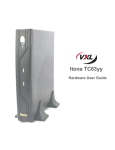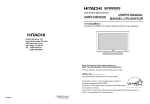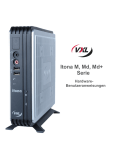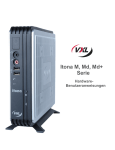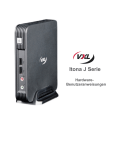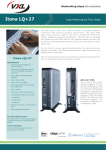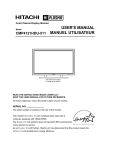Download Vxl TC15yy User guide
Transcript
Itona TC15yy Hardware User Guide Copyright © 2004-2012 VXL Instruments Limited. All Rights Reserved. Information in this document is subject to change without notice and does not represent a commitment on the part of the manufacturer. No part of this guide may be reproduced or transmitted in any form or means, electronic or mechanical, including photocopying and recording, for any purpose, without the express written permission of the manufacturer. Every effort has been made to make this guide as complete and as accurate as possible, but no warranty or fitness is implied. The authors and the publisher shall have neither responsibility nor liability to any person or entity with respect to loss or damages arising from the use of information contained in this guide. This disclaimer does not apply in countries where such provisions are inconsistent with local law. All Trademarks are acknowledged. Last Updated: September, 2012 Version: TC15yy/UG-37-12 VXL Instruments Ltd., House of Excellence, No. 17, Electronics City, Hosur Road, Bangalore– 560 100, INDIA. www.vxl.net Federal Communication Commission (FCC) Statement This equipment has been tested and found to comply with the limits for a Class B digital device, pursuant to Part 15 of the FCC Rules. These limits are designed to provide reasonable protection against harmful interference in a residential installation. This equipment generates uses and can radiate radio frequency energy and, if not installed and used in accordance with the instructions, may cause harmful interference to radio communications. However there is no guarantee that interference will not occur in a particular installation. If this equipment does cause harmful interference to radio or television reception, which can be determined by turning the equipment Off and On, the user is encouraged to try to correct the interference by one or more of the following measures: Re-orient or relocate the receiving antenna. Increase the separation between the equipment and receiver. Connect the equipment to an outlet on a circuit different from that to which the receiver is connected. Consult the dealer or an experienced radio / television technician for help. Each Thin Client is equipped with a FCC compliance label that shows only the FCC identification number. The full information of the associated label is as follows: This device complies with Part 15 of the FCC rules. Operation is subject to the following two conditions: 1. This device may not cause harmful interference. 2. This device must accept any interference received, including interference that may cause undesired operation. i Energy Star Compliant Product ENERGY STAR is a joint program of the U.S. Environmental Protection Agency and the U.S. Department of Energy helping us all save money and protect the environment through energy efficient products practices. Products with the ENERGY STAR logo comply with the ENERGY STAR standard, and the power management feature is enabled by default. The monitor and computer are automatically set to sleep after 15 and 30 minutes of user inactivity. To wake your computer, click the mouse or press any key on the keyboard. Please visit http://www.energy.gov/powermanagement for detail information on power management and its benefits to the environment. In addition, please visit http://www.energystar.gov for detail information on the ENERGY STAR joint program ii Regulatory Certifications iii Table of Contents Federal Communication Commission (FCC) Statement i Energy Star Compliant Product ii Regulatory Certifications iii 1 1 2 3 4 Introduction Features 1 Optional Features 2 About the User Guide 2 Abbreviations and Acronyms 2 Chapters in the Manual 3 Installation 4 Unpacking the Unit 4 Preparing to Connect 4 Connecting the Accessories and Power Supply 5 Connecting to the Server 6 Specifications 8 Hardware 8 Mechanical 8 Environmental Operating 8 Electrical Power 8 Troubleshooting Appendix 9 10 iv 1 Introduction Thin Clients are terminal devices that connect to multi-user application servers operating under Citrix MetaFrame and Windows Server 2000/2003 operating systems. This guide covers installation procedure and hardware details of Itona TC 15yy series.. 1 1. Power Button. 2. USB Ports. 2 Figure 1: ItonaTC15yy Itona TC 15yy series delivers smart and robust solutions for Thin Client computing. They are aesthetically and ergonomically designed compact desktop, providing simultaneous full screen connectivity to Windows and UNIX application servers–a powerful business alternative to users using Win32 applications while continuing access to legacy UNIX applications. They communicate with application servers via the ICA protocol developed by Citrix Systems Inc., Remote Desktop Protocol from Microsoft and a host of other popular connectivity protocols. Please refer to the Software User’s Guide for information about connection protocols supported by this model. Features The product is equipped with a 10/100/1000 Ethernet port that gives an instant connection to a multi-user Windows NT application server. Also provided video display port. USB compatible keyboard/Mouse ports are available for quick setup and use. 1 Introduction Optional Features Wireless LAN is an optional features available for Itona TC15yy series. Note: The optional features cannot be upgraded after the purchase of the product. Please contact the reseller or dealer from whom you purchased the product for information about optional features. About the User Guide This User Guide provides step-by-step instructions to install TC15yy series hardware. The specifications and troubleshooting steps are also included in this User Guide. Abbreviations and Acronyms Abbreviation Expansion AC Alternating Current DC Direct Current LAN Local Area Network LED Light Emitting Diode TCP/IP Transmission Control Protocol/Internet Protocol USB Universal Serial Bus VESA Video Electronics Standards Association VGA Video Graphics Array Table 1: Abbreviations and Acronyms Introduction 2 Chapters in the Manual Chapter No Chapter Name Description 1 Introduction Contains an overview of the product, information about this guide and abbreviations used in this guide. 2 Installation Contains the procedure to set up the hardware. 3 Specifications Contains hardware, mechanical, electrical, interface and operating environment specifications. 4 Troubleshooting Contains solutions to problems that you may encounter while using the product. — Appendix Contains detailed specifications for connectors and cables used with the product. Table 2: List of Chapters Warning Do not open enclosure, hazardous voltages present inside equipment. Any changes or modifications not expressly approved by the party responsible for compliance could void the user's authority to operate this equipment. There is no user serviceable part inside. Do not open enclosure, hazardous voltages present in the equipment’s components. Do not disassemble the equipment as this can nullify your warranty. This equipment must be earthed to prevent accidental electric shocks, connect a three pin connector to ensure adequate earthing. As a precaution, the AC socket outlet should be near the equipment and should be easily accessible. Sound Power Level is less than 60dB (A), when measured according to ISO 7779. Caution 3 Ensure that all expansion slots (on the back or side of the client) are covered with metal retaining brackets, and tightly attached to the computer cabinet. Only equipment certified to comply with Class B (computer input/output devices, terminals, printers etc.) should be connected to this equipment, and must have shielded interface cables. This equipment should not be used in electro-medical applications. Do not operate this equipment in corrosive or explosive atmosphere. Operate this equipment within specified temperature limits. Introduction 2 Installation You have to install the client before you can use it. Installation involves setting up the hardware and connecting the peripherals required for normal use. To install the Itona TC15yy series hardware, perform the following steps: 1. Unpack the unit. 2. Prepare to connect. 3. Connect the accessories and power. 4. Connect to the server Each step is explained in detail in this chapter. Unpacking the Unit Unpack the unit from its carton box, handle safely to ensue you do not damage any components during unpacking. The carton in which the product was shipped to you contains the following: Itona TC15yy Series Thin Client Power Adapter AC-DC 16V/2.5A Power cord Pedestal DVI-I to VGA and DVI cable (optional) Wall / VESA mounting bracket (optional) Mouse (optional) Hardware Installation Guide Note: Please retain the original carton and packing material for future use. Preparing to Connect 1. Ensure that the following are available at the site where you want to install the product. 100~240V AC, 0.65A, 50/60 Hz, 3-pin power inlet for power adapter. Note: Ensure that the power inlet plug is regulated and earthed. A floating ground/chassis could cause an electric shock. Well ventilated, clean, dry and dust free atmosphere. Specified environmental conditions. For more information see, Environmental Operating Specifications on page 8. Table or desk of suitable size. 2. Fix the pedestals at the bottom of the thin client. Installation 4 3. Place the product on the table in a location that provides quick and easy access to the power Inlet plug to shutdown the power in emergencies. 4. Ensure a minimum space of 2 inches (5 cm) on all sides of the unit for efficient convection cooling. Connecting the Accessories and Power Supply The various connectors available on the rear panel of the client are shown in Figure 2. 1. Wireless LAN 2. DVI-I Port 3. Ethernet Port 4. Mic 5. 3 USB port 6. DC input 16V /2.5A 7. Pedestal 8. Line Out Figure 2: Itona TC15yy Series Rear View 5 Installation Connectors Connector Symbol DVI-I port USB port Audio output (LINE OUT) port Microphone input port RJ45 Ethernet port Table 3: Connector Symbols Note: Before connecting any cables, ensure that the power cable is unplugged from the unit. To connect various accessories and power supply: 1. Connect the DVI cable from your display unit to the DVI-I port. 2. Connect the USB devices to the USB ports. 3. Connect the external powered speakers to the audio output (LINE OUT) port. 4. Connect the microphone to the microphone input port. 5. Connect the mouse and keyboard to the USB slots. 6. Connect the LAN cable to the RJ45 Ethernet port. 7. Connect the DC power adapter to the DC power in. Caution: Ensure the Power Rating Spec before Connecting Power Cable. Ensure that Video port adequately fastened with the screws provided with the cables. Connecting to the Server The Thin Client can be physically connected to the server/network by connecting to LAN through TCP/IP. To connect client to LAN through TCP/IP: 1. Connect one end of a 10/100/1000 cable to the Ethernet LAN port of the client. 2. Connect the other end to a LAN hub as shown in Figure 3. Installation 6 Figure 3: LAN Connection through TCP/IP 3. Press the power button to switch on the ItonaTC15yy series thin client. The front panel LED lights up and the client starts with a beep sound. The Connection Manager screen appears. Note: To configure the client, refer to the Software User’s Guide. 7 Installation 3 Specifications Hardware Processor VIA C7 / TC1000 VGA Memory Shared Video Memory 32MB max Flash IDE 44Pin / 90D RAM DDR2 SO DIMM Networking 10/100/1000Mbps Power Supply External Adapter Display Support 1920x1200 60Hz 16/32 Bits Mechanical Height 190 mm Width 36.5 mm Depth 142 mm Weight 0.7 Kg (max) Environmental Operating Operating temperature + 5oC to +35oC Storage temperature - 20o C to +60oC Humidity 20% to 80% RH Max noncondensing Electrical Power 2.5A/16V external adapter, 40 Watts Specifications 8 4 Troubleshooting This chapter contains solutions for problems you may encounter while using the product. 9 Problem Solution The power-LED on front panel does not glow when the client is switched on. Ensure that the power cord is plugged into an AC outlet. There is no display on the monitor, though the powerindicating LED glows. Ensure the monitor is plugged in to the terminal. The mouse (or keyboard) does not work when the client is switched on. Ensure that the mouse (or keyboard) is plugged into the correct USB port on the rear panel. Check the fuse in the power-plug, if available. Ensure that the VGA connector is plugged in to the terminal. Troubleshooting Appendix Connectors The following section provides pin details for various connectors on the rear panel of the client. 10/100/1000 Ethernet LAN Port RJ-45 modular 8-pin jack. 10/100/1000 Mbps. Pin Signal 1 TxD+ 2 TxD- 3 RxD+ 6 RxD- DVI-I Port Pin C1 to C5 carry the analogue signal.24+ 5 pin DVI Connector. Appendix Pin Signal Pin Signal Pin Signal 1 TMDS Data 2- 11 TMDS Data 1/3 Shield 21 TMDS Data 5+ 2 TMDS Data 2+ 12 TMDS Data 3- 22 TMDS Clock Shield 3 TMDS Data 2/4 Shield 13 TMDS Data 3+ 23 4 TMDS Data 4- 14 +5 V Power 24 TMDS Clock - 5 TMDS Data 4+ 15 Ground(for+5V) C1 Analog Red TMDS Clock + 10 6 DDC Clock 16 Hot Plug Detect C2 Analog Green 7 DDC Data 17 TMDS Data 0- C3 Analog Blue 8 Analog Vertical Sync 18 C4 Analog Horizontal Sync 9 TMDS Data 1- 19 C5 Analog Ground (analog R, G & B return) 10 TMDS Data 1+ 20 TMDS Data 0+ TMDS Data 0/5 Shield TMDS Data 5- Audio / Microphone Port Standard audio jacks. USB Port 4-pin series-A receptacle. 4~ 5 ports depending on the model. Both USB1.1 and USB2.0 models are available 11 Pin Signal 1 VCC 2 D- 3 D+ 4 GND Appendix


















